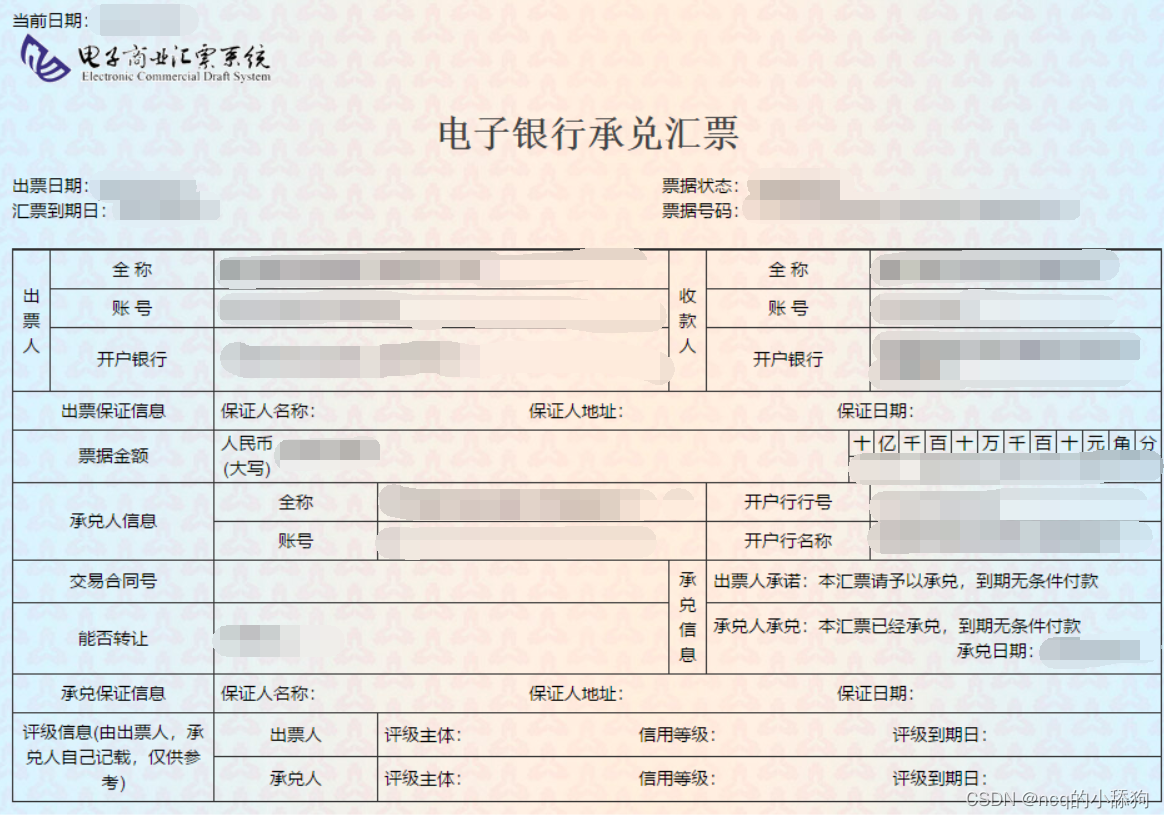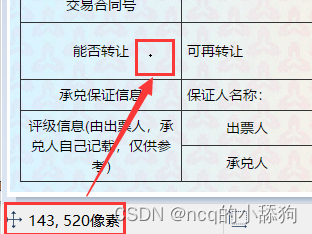发票账单很多?python助你批量完成数据提取
迪丽瓦拉
2025-05-28 10:42:33
0次

每天面对成堆的发票,无论是税务发票还是承兑单据,抑或是其他各类公司数据要从照片、PDF等不同格式的内容中提取,我们都有必要进行快速办公的能力提升。
因此,我们的目标要求就十分明显了,首先要从图片中获取数据,其次将数据统一导入到EXCEL中。
配置需求:
1.ImageMagick : https://download.csdn.net/download/yyfloveqcw/87579790
2.tesseract-OCR : https://download.csdn.net/download/yyfloveqcw/87579801
3.Python3.7
4.from PIL import Image as PI
5.import io
6.import os
7.import pyocr.builders
8.from cnocr import CnOcr
9.import xlwt

分析上图发现票据金额为“贰拾万元整”,数据金额为大写中文,因此在导入Excel之前我们需要将金额票据的数据转换成数字的格式,基于此,我们需要首先完成大写汉字和数字的转换。
def chineseNumber2Int(strNum: str):result = 0temp = 1 # 存放一个单位的数字如:十万count = 0 # 判断是否有chArrcnArr = ['壹', '贰', '叁', '肆', '伍', '陆', '柒', '捌', '玖']chArr = ['拾', '佰', '仟', '万', '亿']for i in range(len(strNum)):b = Truec = strNum[i]for j in range(len(cnArr)):if c == cnArr[j]:if count != 0:result += tempcount = 0temp = j + 1b = Falsebreakif b:for j in range(len(chArr)):if c == chArr[j]:if j == 0:temp *= 10elif j == 1:temp *= 100elif j == 2:temp *= 1000elif j == 3:temp *= 10000elif j == 4:temp *= 100000000count += 1if i == len(strNum) - 1:result += tempreturn result通过上述代码即可实现大写字母与数字的转换,例如输入“贰拾万元整”即可导出“200000”,再将其转换成数字后即可极大地简化表格的操作,也可以在完成表格操作的同时有利于数据归档。
接下来,我们需要分析发票的内部内容,分析下图可知,我们需要获取以下几个数据内容:“出票日期”、“汇票到账日期”、“票据号码”、“收款人”、“票据金额”、“出票人”,可以通过画图软件获取精准定位。

如图,小黑点即鼠标所在地,画图软件左下角即他的坐标。

提取出票日期
def text1(new_img):#提取出票日期left = 80top = 143right = 162bottom = 162image_text1 = new_img.crop((left, top, right, bottom))#展示图片#image_text1.show()txt1 = tool.image_to_string(image_text1)print(txt1)return str(txt1)2.提取金额
def text2(new_img):#提取金额left = 224top = 355right = 585bottom = 380image_text2 = new_img.crop((left, top, right, bottom))#展示图片#image_text2.show()image_text2.save("img/tmp.png")temp = ocr.ocr("img/tmp.png")temp="".join(temp[0])txt2=chineseNumber2Int(temp)print(txt2)return txt23.提取出票人
def text3(new_img):#提取出票人left = 177top = 207right = 506bottom = 231image_text3 = new_img.crop((left, top, right, bottom))#展示图片#image_text3.show()image_text3.save("img/tmp.png")temp = ocr.ocr("img/tmp.png")txt3="".join(temp[0])print(txt3)return txt34.提取付款行
def text4(new_img):#提取付款行left = 177top = 274right = 492bottom = 311image_text4 = new_img.crop((left, top, right, bottom))#展示图片#image_text4.show()image_text4.save("img/tmp.png")temp = ocr.ocr("img/tmp.png")txt4="".join(temp[0])print(txt4)return txt45.提取汇票到账日期
def text5(new_img):#提取汇票到日期left = 92top = 166right = 176bottom = 184image_text5 = new_img.crop((left, top, right, bottom))#展示图片#image_text5.show()txt5 = tool.image_to_string(image_text5)print(txt5)return txt56.提取票据单据
def text6(new_img):#提取票据号码left = 598top = 166right = 870bottom = 182image_text6 = new_img.crop((left, top, right, bottom))#展示图片#image_text6.show()txt6 = tool.image_to_string(image_text6)print(txt6)return txt6在将数据全部提取完成之后,即进入设置环节,我们需要首先将所有账单文件进行提取,获取他们的文件名和路径。
ocr=CnOcr()
tool = pyocr.get_available_tools()[0]
filePath='img'
img_name=[]
for i,j,name in os.walk(filePath):img_name=name在获取完整后,即可进行数据导入Excel的操作。
count=1
book = xlwt.Workbook(encoding='utf-8',style_compression=0)
sheet = book.add_sheet('test',cell_overwrite_ok=True)
for i in img_name:img_url = filePath+"/"+iwith open(img_url, 'rb') as f:a = f.read()new_img = PI.open(io.BytesIO(a))## 写入csvcol = ('年份','出票日期','金额','出票人','付款行全称','汇票到日期','备注')for j in range(0,7):sheet.write(0,j,col[j])book.save('1.csv')shijian=text1(new_img)sheet.write(count,0,shijian[0:4])sheet.write(count,1,shijian[5:])sheet.write(count,2,text2(new_img))sheet.write(count,3,text3(new_img))sheet.write(count,4,text4(new_img))sheet.write(count,5,text5(new_img))sheet.write(count,6,text6(new_img))count = count + 1至此,完整流程结束。
附上源码全部:
from wand.image import Image
from PIL import Image as PI
import pyocr
import io
import re
import os
import shutil
import pyocr.builders
from cnocr import CnOcr
import requests
import xlrd
import xlwt
from openpyxl import load_workbookdef chineseNumber2Int(strNum: str):result = 0temp = 1 # 存放一个单位的数字如:十万count = 0 # 判断是否有chArrcnArr = ['壹', '贰', '叁', '肆', '伍', '陆', '柒', '捌', '玖']chArr = ['拾', '佰', '仟', '万', '亿']for i in range(len(strNum)):b = Truec = strNum[i]for j in range(len(cnArr)):if c == cnArr[j]:if count != 0:result += tempcount = 0temp = j + 1b = Falsebreakif b:for j in range(len(chArr)):if c == chArr[j]:if j == 0:temp *= 10elif j == 1:temp *= 100elif j == 2:temp *= 1000elif j == 3:temp *= 10000elif j == 4:temp *= 100000000count += 1if i == len(strNum) - 1:result += tempreturn resultdef text1(new_img):#提取出票日期left = 80top = 143right = 162bottom = 162image_text1 = new_img.crop((left, top, right, bottom))#展示图片#image_text1.show()txt1 = tool.image_to_string(image_text1)print(txt1)return str(txt1)
def text2(new_img):#提取金额left = 224top = 355right = 585bottom = 380image_text2 = new_img.crop((left, top, right, bottom))#展示图片#image_text2.show()image_text2.save("img/tmp.png")temp = ocr.ocr("img/tmp.png")temp="".join(temp[0])txt2=chineseNumber2Int(temp)print(txt2)return txt2def text3(new_img):#提取出票人left = 177top = 207right = 506bottom = 231image_text3 = new_img.crop((left, top, right, bottom))#展示图片#image_text3.show()image_text3.save("img/tmp.png")temp = ocr.ocr("img/tmp.png")txt3="".join(temp[0])print(txt3)return txt3
def text4(new_img):#提取付款行left = 177top = 274right = 492bottom = 311image_text4 = new_img.crop((left, top, right, bottom))#展示图片#image_text4.show()image_text4.save("img/tmp.png")temp = ocr.ocr("img/tmp.png")txt4="".join(temp[0])print(txt4)return txt4
def text5(new_img):#提取汇票到日期left = 92top = 166right = 176bottom = 184image_text5 = new_img.crop((left, top, right, bottom))#展示图片#image_text5.show()txt5 = tool.image_to_string(image_text5)print(txt5)return txt5
def text6(new_img):#提取票据号码left = 598top = 166right = 870bottom = 182image_text6 = new_img.crop((left, top, right, bottom))#展示图片#image_text6.show()txt6 = tool.image_to_string(image_text6)print(txt6)return txt6ocr=CnOcr()tool = pyocr.get_available_tools()[0]filePath='img'
img_name=[]
for i,j,name in os.walk(filePath):img_name=name
count=1book = xlwt.Workbook(encoding='utf-8',style_compression=0)
sheet = book.add_sheet('test',cell_overwrite_ok=True)for i in img_name:img_url = filePath+"/"+iwith open(img_url, 'rb') as f:a = f.read()new_img = PI.open(io.BytesIO(a))## 写入csvcol = ('年份','出票日期','金额','出票人','付款行全称','汇票到日期','备注')for j in range(0,7):sheet.write(0,j,col[j])book.save('1.csv')shijian=text1(new_img)sheet.write(count,0,shijian[0:4])sheet.write(count,1,shijian[5:])sheet.write(count,2,text2(new_img))sheet.write(count,3,text3(new_img))sheet.write(count,4,text4(new_img))sheet.write(count,5,text5(new_img))sheet.write(count,6,text6(new_img))count = count + 1
上一篇:C语言--字符串函数2
相关内容
热门资讯
Linux-scheduler...
四、调度域 SDTL结构 linux内核使用SDTL结构体来组织CPU的层次关系 struct sc...
托福口语21天——day5 发...
目录 一、连读纠音 二、语料输入+造句输出 三、真题 一、连读纠音 英语中的连读方式有好几种...